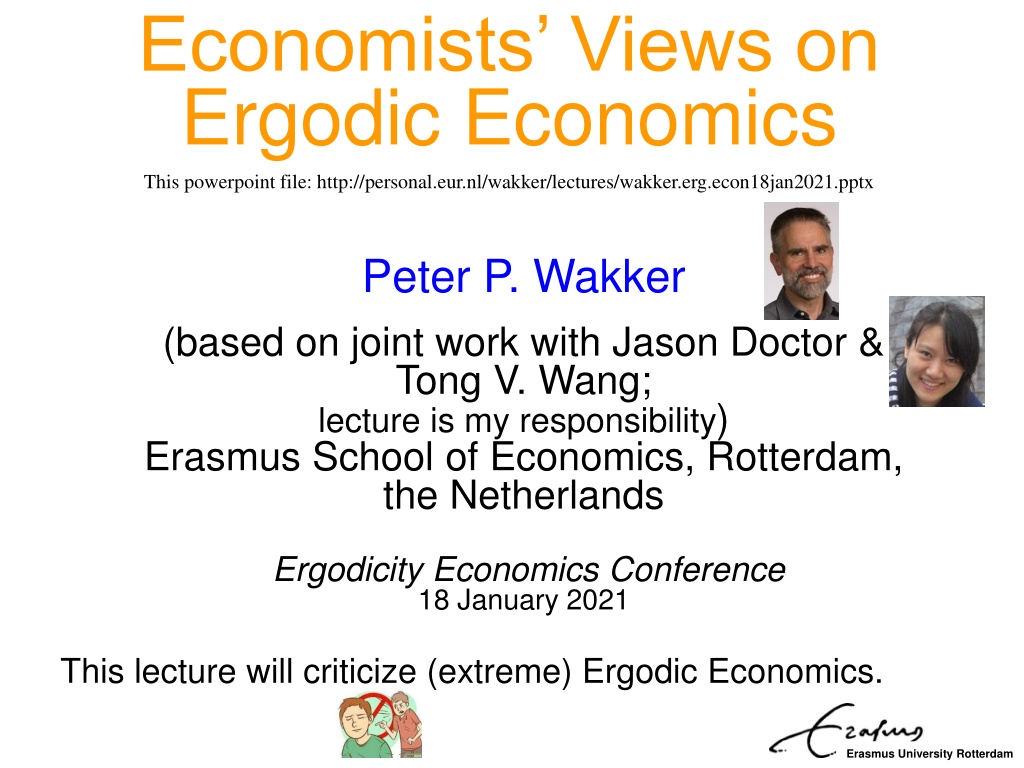
Critique of Extreme Ergodic Economics by Economists
Explore the critical lecture by Peter P. Wakker at the Ergodicity Economics Conference, Rotterdam, analyzing the flaws of Extreme Ergodic Economics. The presentation dissects the Ubiquity Fallacy, Ergodicity theory, and the limitations of applying growth-over-time to encompass all economic scenarios, showcasing examples of the Ubiquity Fallacy in various fields.
Download Presentation

Please find below an Image/Link to download the presentation.
The content on the website is provided AS IS for your information and personal use only. It may not be sold, licensed, or shared on other websites without obtaining consent from the author. If you encounter any issues during the download, it is possible that the publisher has removed the file from their server.
You are allowed to download the files provided on this website for personal or commercial use, subject to the condition that they are used lawfully. All files are the property of their respective owners.
The content on the website is provided AS IS for your information and personal use only. It may not be sold, licensed, or shared on other websites without obtaining consent from the author.
E N D
Presentation Transcript
Economists Views on Ergodic Economics This powerpoint file: http://personal.eur.nl/wakker/lectures/wakker.erg.econ18jan2021.pptx Peter P. Wakker (based on joint work with Jason Doctor & Tong V. Wang; lecture is my responsibility) Erasmus School of Economics, Rotterdam, the Netherlands Ergodicity Economics Conference 18 January 2021 This lecture will criticize (extreme) Ergodic Economics. Erasmus University Rotterdam
Outline: 1. The Ubiquity Fallacy 2. EEE s Criticism of Expected Utility Criticized 3. EEE s Criticism of All of Economics Criticized 4. Further Criticisms of EEE 5. Citations from EEE papers 6. Conclusion 2
Imagine: you study a set (ensemble). ensemble Elementary particles/systems/ E.g.: persons , e.g. from UK . We are interested in properties of persons. E.g., wealth . 3
Everything progresses in time: The ergodic figure time | ensemble Often probability measure ? on ensemble (e.g., relative frequencies). 4
time ensemble Sometimes: average over ensemble = average over time . Ergodicity. Convenient! Birkhoff Ergodic theory studies: - growth over time; - its lessons. 5
The ergodic figure is ubiquitous: can capture every situation. 6
Moderate ergodic economics: ergodic theory can answer some questions in economics. I: Extreme ergodic economics (EEE): (Peters 2019, Nature Physics; Peters & Gell-Mann 2016, Chaos) ergodic theory can answer all questions in economics. I: ??? But didn t I claim ubiquity ??? 7
1ubfa EEE commits ubiquity fallacy. One way to see that EEE incorrect: Ensemble = everything in economics/life except growth-over-time ; too broad to be captured by only growth-over-time . A faster cure: showing similar ubiquity fallacies. 8
Other examples of ubiquity fallacy: Risk is ubiquitous: risk theory can answer all questions. Molecules are ubiquitous: physics can answer all questions. All decisions come from our brains: neuroscience can answer all questions. Everything can be captured in equations: maths can answer all questions. Human interactions are ubiquitous: game theory can answer all questions. Further: All Life Is Electromagnetic, We Are Our Brains, We Are Shaped by Evolution, Time is ubiquitous: ergodic theory can answer all questions. All above claims are equally (in)valid. Providing some insights providing all insights. At http://personal.eur.nl/wakker/refs/webrfrncs.docx the keyword own small expertise = meaning of life has listed authors misusing this fallacy for many years. 9
Outline: 1. The Ubiquity Fallacy 2. EEE s Criticism of Expected Utility Criticized 3. EEE s Criticism of All of Economics Criticized 4. Further Criticisms of EEE 5. Citations from EEE papers 6. Conclusion 10
2 up 3 up 4 up 5 up 1 up 6 up DM DM DM DM DM DM 2500 2000 1000 + 1000 + 2000 + 3000 Calculate 6? 2000 +1 Accept if Accept or reject? 1 6? 2500 +1 EU: Determine ?. 6? 1000 +1 6? 3000> ?(0). 6? 2000 +1 6? 1000 +1 EEE: EU is an average!!!??? (1) over time, (2) over ensemble. So, either or - Sometimes EEE wrongly assumes (1)2avti. Then wrongly criticizes EU for implicit ergodicity.3euer But, EU is by (2), not by (1)! - Other times, EEE correctly assumes (2). Then wrongly thinks that 6 DMs must exist in some concrete physical sense4enco (as in UK example). Mysterious EEE-ban on average-calculation for above puppet. 11
I worked 8 years in hospital (career award 2007 Medical Decision Making Society). Many cases were individual & static (e.g., chronic health states). We did calculate averages (EU) there. We violated the EEE ban!?!? I & 100s of colleagues in medical decision making in trouble. EEE does not propose alternative calculations that would be allowed. Confusing Economists justify EU by preference axiomatizations (von Neumann-Morgenstern 47) & data fitting/predicting (Starmer 00). Also, many criticize EU! All of this is ignored by EEE. 12
Outline: 1. The Ubiquity Fallacy 2. EEE s Criticism of Expected Utility Criticized 3. EEE s Criticism of All of Economics Criticized 4. Further Criticisms of EEE 5. Citations from EEE papers 6. Conclusion 13
EEE: we found a problem in EU EEE: that provides new insights EEE: such insights refute all of economics 5alec I: I: I: Economics is way broader! Refuting one economic theory refuting all. Many problems in EU are known! 14
Outline: 1. The Ubiquity Fallacy 2. EEE s Criticism of Expected Utility Criticized 3. EEE s Criticism of All of Economics Criticized 4. Further Criticisms of EEE 5. Citations from EEE papers 6. Conclusion 15
Further criticisms of EEE EEE finds (useful!) isomorphisms with other fields (technique not new: Keeney & Raiffa 1976 Ch. 9; Wakker 2010 Appendix D). EEE: Makes other fields redundant. 6isre Providing some insights providing all. In temporal growth, growth factor often not proper index7grfa: Doctor, Wakker, & Wang (2020 Example 1) Life-cycle consumption theory (Browning & Crossley 2001) Economic growth theory (Barro & Sala-i-Martin 2004) Exponential growth bias (Levy & Tasoff 2020; Stango & Zinman 2009) 16
Outline: 1. The Ubiquity Fallacy 2. EEE s Criticism of Expected Utility Criticized 3. EEE s Criticism of All of Economics Criticized 4. Further Criticisms of EEE 5. Citations from EEE papers 6. Conclusion 17
I repeat here the superscripts indicating my criticisms of EEE. 1ubfa: Ubiquity fallacy regarding time 2avti: EU is average over time 3euer: EU assumes ergodicity 4enco: All ensemble members must exist in some concrete physical sense 5alec: all of economics is invalidated 6isre: isomorphisms make other fields entirely redundant 7grfa: in intertemporal, growth factor should be maximized 8th criticism concerns an absence: absence of any mention of the arguments that economists provide to justify and criticize EU (preference axiomatizations and empirical performance). Similar for dynamic optimization. On next slides follow citations from Peters (2019) and Peters & Gell-Mann (2016), with superscripts added to indicate my criticisms. (Superscripts for literature references in original have been dropped.) 18
My criticisms of Peters (2019 Nature Physics) Abstract: It may therefore come as a surprise to learn that the prevailing formulations of economic theory5alec expected utility theory and its descendants make an indiscriminate assumption of ergodicity. 3euer P. 1216: And it turns out a surprising reframing of economic theory5alec follows directly from asking the core ergodicity question1ubfa: At a crucial place in the foundations of economics5alec, it is assumed that the answer is always yes3euer a pernicious error P. 1216: I stumbled on this error about a decade ago If we pay close attention to the ergodicity problem1ubfa, natural solutions emerge. We therefore have reason to be optimistic about the future of economic theory5alec Pp. 1216-2017: Placing considerations of time and ergodicity centre stage1ubfa, we will arrive at a clear interpretation both of discounting and of utility theory, without appealing to subjective psychology or indeed other forms of personalization6isre P. 1218: in maximizing the expectation value an ensemble average over all possible outcomes of the gamble expected utility theory implicitly assumes that individuals can interact with copies of themselves4enco, effectively in parallel universes (the other members of the ensemble). An expectation value of a non-ergodic observable physically corresponds to pooling and sharing among many entities.4enco That may reflect what happens in a specially designed large collective, but it doesn t reflect the situation of an individual decision-maker.4enco Expected utility theory computes what happens to a loosely specified model of my psychology averaged across a multiverse. But I do not live spread out across a multiverse, let alone harvest the average psychological consequences of the actions of my multiverse clones.4enco P. 1218: the equations that appear in the two frameworks can be very similar. conceptually the two approaches couldn t be more different.6isre P. 2018: Perhaps people aren t so different, but their circumstances are.6isre P. 2019: For that to make any sense in the context of individuals making financial decisions, an ergodic observable had to be created. Expected utility theory unknowingly, because ergodicity hadn t been invented did just that3euer But because of the lack of conceptual clarity, the entire field of economics5alec drifted in a direction that places too much emphasis on psychology.6isre P. 1220: One has to relabel and rearrange some terms in the relevant equation, but eventually the ergodic growth rate is recovered as the fundamental concept that explains the phenomenon6isre; 7grfa. The same is true for expected utility theory.6isre; 7grfa P. 1220: economics is firmly stuck in the wrong conceptual space ... it is also uplifting and scientifically exciting because of the many opportunities that have just opened up.5alec P. 1220: Nor do we have to assume huge individual differences in psychology or skill to explain the huge observed differences in wealth: a trivial null model though one that doesn t blindly assume ergodicity predicts the robust features of the wealth distribution6isre; 7grfa. A well-known measure of inequality turned out to be the time-integrated difference between ensemble and time-average growth rates in geometric Brownian motion.6isre P 1221: We have reason to hope for a future economic science that is more parsimonious, conceptually clearer and less subjective. It will resemble reality more closely and be better aligned with our moral intuitions.5alec 19
My criticisms of Peters & Gell-Mann (2016 Chaos) P. 1. Abstract: expectation values are only meaningful in the presence of ensembles4enco or in systems with ergodic properties3euer, whereas decision-makers have no access to ensembles4enco, and the variables representing wealth in the usual growth models do not have the relevant ergodic properties3euer. Simultaneously addressing the shortcomings of utility and those of expectations, we propose to evaluate gambles by averaging wealth growth over time.2avti; 1ubfa leads to a novel approach to economics5alec current economic theory5alec assumes that expectation values reflect what happens over time.2avti such processes constitute the essential models of economics. 5alec nowadays expectation values are often used to evaluate situations where time averages would be appropriate instead2avti the process needs to be transformed to find an appropriate ergodic observable.3euer; 1ubfa We argue that this null model is a priori a bad starting point because the expectation value of wealth does not generally reflect what happens over time. 2avti ; 1ubfa We propose a different null model of human behavior that eliminates, in many cases, the need for utility theory: 6isre P.2 Section III is a modern treatment of the problem, using dynamics, that is, we use information about temporal behavior, not exclusively measure-theoretic probabilistic information. 2avti; 1ubfa Expectation values play a central role in economics,5alec essentially for two reasons. First, the expectation value of any observable is, by definition, the average over N instances of the observable, in the limit ? . It can therefore be relevant for a member of a large resource-sharing group. Decision theory, however, is concerned with individuals, not with groups, wherefore we disregard this first possible reason for using expectation values.4enco Second, an observable may have the ergodic property mentioned in Section I, in which case it is informative of what happens to an individual over time.3euer Both quantities were suggested as criteria to evaluate a gamble, although their dynamic significance was overlooked, and time scales dt were usually omitted and implicitly set to 1.1ubfa;2avti We conclude in Section V that the modern dynamic perspective1ubfa Rather, we propose as a null model to define rationality as maximizing the time-average growth of wealth.7grfa; 1ubfa P. 3 Requesting the specification of a dynamic exposes as underspecified the original set-up of many problems in economics.1ubfa5alec the overall quality of a gamble is a weighted average over outcomes, as if all possibilities were materializing simultaneously with different degrees of reality.4enco we argue that a dynamic is needed in addition to the random variable, turning the gamble into a stochastic process. Dynamics means repetition, and requiring the specification of a dynamic is requiring the admission that we live through time1ubfa, not in a superverse of parallel worlds with which we can share resources.4enco it s more or less impossible to consider any gamble as happening outside of time1ubfa The typical decision problem only makes sense in the context of a notion of irreversible time and dynamics1ubfa P. 4 under multiplicative dynamics, the rate of change in the logarithm of wealth is an ergodic observable, and he who chooses wisely with respect to its expectation value also chooses wisely with respect to the time average.7grfa P. 5 reality imposes a dynamic and corresponding ergodic growth rates on the decision-maker.1ubfa;7grfa The expectation value would be relevant over T rounds if the individual were part of a large resourcesharing group mimicking a statistical ensemble,4enco It would also be relevant if would then be ergodic and the expectation value would reflect how the individual fares over time.2avti3euer P. 8 Maximizing expectation values of observables that do not have the ergodic property of Section I cannot be considered rational for an individual. Instead, it is more useful to consider rational the optimization of time-average performance, or of expectation values of appropriate ergodic observables.7grfa; 1ubfa deep insight is gained by finding the right object to optimize we suggest time-average growth.7grfa; 1ubfa defining an ergodic observable for multiplicative dynamics. This point of view provides a firm basis on which to erect a scientific formalism.5alec; 1ubfa The problems listed there as those of greatest importance to the discipline at the moment can be addressed using the modern dynamic perspective.5alec P. 9 Applications to ecology and biology seem natural.5alec 20
References Barro, Robert J. & Xavier Sala-i-Martin (2004) Economic Growth (2nd ed.). McGraw-Hill, New York. Browning, Martin & Thomas F. Crossley (2001) The Life-Cycle Model of Consumption and Saving, Journal of Economic Perspectives 15, 3 22. Doctor, Jason N., Peter P. Wakker, & Tong V. Wang (2020) Economists Views on the Ergodicity Problem, Nature Physics 16, 1168 (2020). https://doi.org/10.1038/s41567-020-01106-x Doctor, Jason N., Peter P. Wakker, & Tong V. Wang (2020) Supplementary Information on Doctor, Wakker, & Wang (2020, Nature Physics 16, 1168. Kahneman, Daniel & Amos Tversky (1979) Prospect Theory: An Analysis of Decision under Risk, Econometrica 47, 263 291. Keeney, Ralph L. & Howard Raiffa (1976) Decisions with Multiple Objectives. Wiley, New York (2nd edn. 1993, Cambridge University Press, Cambridge). Levy, Matthew R. & Joshua Tasoff (2020) Exponential Growth Bias in Experimental Consumption Decisions, Economica 87, 52 80. Peters, Ole (2019) The Ergodicity Problem in Economics, Nature Physics 15, 1216 1221. Peters, Ole & Murray Gell-Mann (2016) Evaluating Gambles Using Dynamics, Chaos 26, https://doi.org/10.1063/1.4940236. Savage, Leonard J. (1954) The Foundations of Statistics. Wiley, New York. (2nd edn. 1972, Dover Publications, New York.) Stango, Victor & Jonathan Zinman (2009) Exponential Growth Bias and Household Finance, Journal of Finance 64, 2807 2849. Starmer, Chris (2000) Developments in Non-Expected Utility Theory: The Hunt for a Descriptive Theory of Choice under Risk, Journal of Economic Literature 38, 332 382. von Neumann, John & Oskar Morgenstern (1944, 1947, 1953) Theory of Games and Economic Behavior. Princeton University Press, Princeton NJ. Wakker, Peter P. (2010) Prospect Theory: For Risk and Ambiguity. Cambridge University Press, Cambridge, UK. Wakker, Peter .P. (2020) Annotated Bibliography. http://personal.eur.nl/wakker/refs/webrfrncs.docx (updated yearly March 16). Wakker, Peter P. (2021), this powerpoint file: http://personal.eur.nl/wakker/lectures/wakker.erg.econ18jan2021.pptx 21
Outline: 1. The Ubiquity Fallacy 2. EEE s Criticism of Expected Utility Criticized 3. EEE s Criticism of All of Economics Criticized 4. Further Criticisms of EEE 5. Citations from EEE papers 6. Conclusion 22
EEE in prominent physics journal: does not signal any problem in economics. Does signal a problem in physics: Some physicists are na ve & haughty. 23







